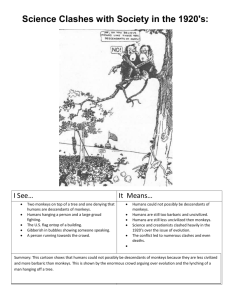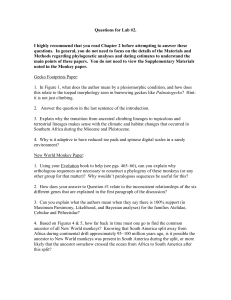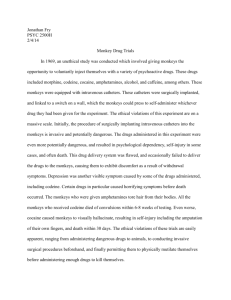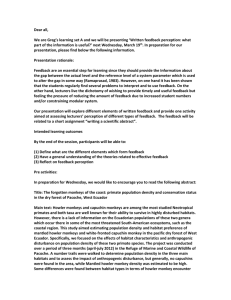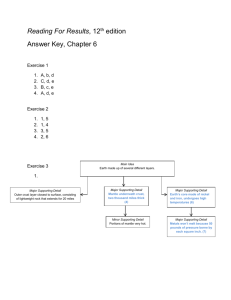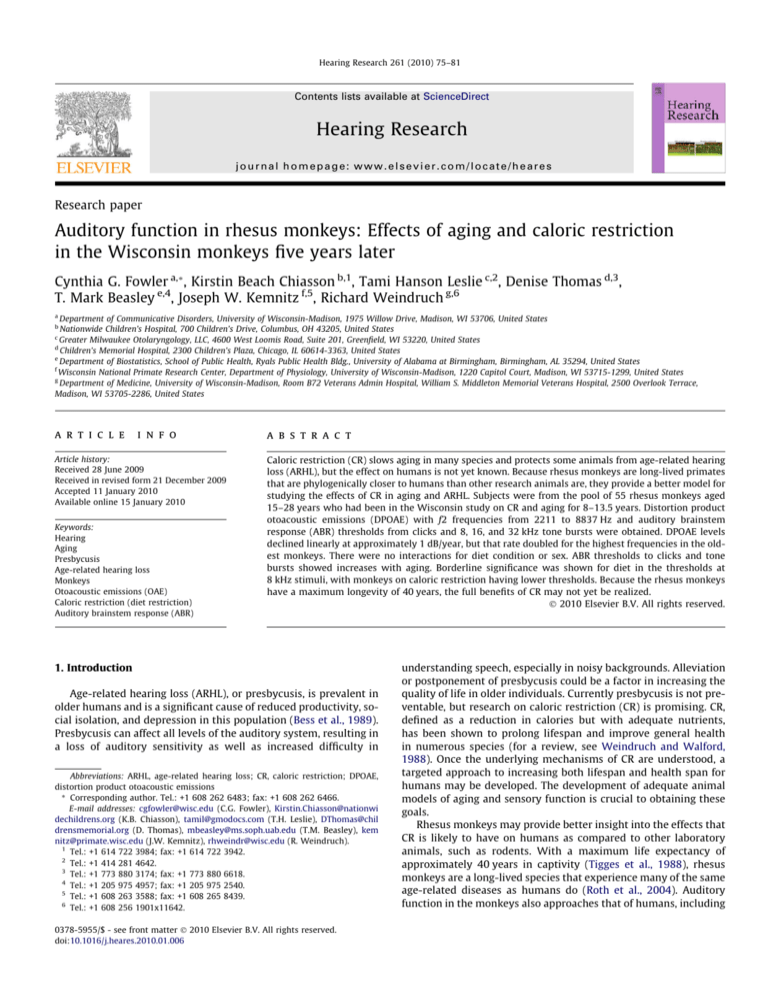
Hearing Research 261 (2010) 75–81
Contents lists available at ScienceDirect
Hearing Research
journal homepage: www.elsevier.com/locate/heares
Research paper
Auditory function in rhesus monkeys: Effects of aging and caloric restriction
in the Wisconsin monkeys five years later
Cynthia G. Fowler a,*, Kirstin Beach Chiasson b,1, Tami Hanson Leslie c,2, Denise Thomas d,3,
T. Mark Beasley e,4, Joseph W. Kemnitz f,5, Richard Weindruch g,6
a
Department of Communicative Disorders, University of Wisconsin-Madison, 1975 Willow Drive, Madison, WI 53706, United States
Nationwide Children’s Hospital, 700 Children’s Drive, Columbus, OH 43205, United States
Greater Milwaukee Otolaryngology, LLC, 4600 West Loomis Road, Suite 201, Greenfield, WI 53220, United States
d
Children’s Memorial Hospital, 2300 Children’s Plaza, Chicago, IL 60614-3363, United States
e
Department of Biostatistics, School of Public Health, Ryals Public Health Bldg., University of Alabama at Birmingham, Birmingham, AL 35294, United States
f
Wisconsin National Primate Research Center, Department of Physiology, University of Wisconsin-Madison, 1220 Capitol Court, Madison, WI 53715-1299, United States
g
Department of Medicine, University of Wisconsin-Madison, Room B72 Veterans Admin Hospital, William S. Middleton Memorial Veterans Hospital, 2500 Overlook Terrace,
Madison, WI 53705-2286, United States
b
c
a r t i c l e
i n f o
Article history:
Received 28 June 2009
Received in revised form 21 December 2009
Accepted 11 January 2010
Available online 15 January 2010
Keywords:
Hearing
Aging
Presbycusis
Age-related hearing loss
Monkeys
Otoacoustic emissions (OAE)
Caloric restriction (diet restriction)
Auditory brainstem response (ABR)
a b s t r a c t
Caloric restriction (CR) slows aging in many species and protects some animals from age-related hearing
loss (ARHL), but the effect on humans is not yet known. Because rhesus monkeys are long-lived primates
that are phylogenically closer to humans than other research animals are, they provide a better model for
studying the effects of CR in aging and ARHL. Subjects were from the pool of 55 rhesus monkeys aged
15–28 years who had been in the Wisconsin study on CR and aging for 8–13.5 years. Distortion product
otoacoustic emissions (DPOAE) with f2 frequencies from 2211 to 8837 Hz and auditory brainstem
response (ABR) thresholds from clicks and 8, 16, and 32 kHz tone bursts were obtained. DPOAE levels
declined linearly at approximately 1 dB/year, but that rate doubled for the highest frequencies in the oldest monkeys. There were no interactions for diet condition or sex. ABR thresholds to clicks and tone
bursts showed increases with aging. Borderline significance was shown for diet in the thresholds at
8 kHz stimuli, with monkeys on caloric restriction having lower thresholds. Because the rhesus monkeys
have a maximum longevity of 40 years, the full benefits of CR may not yet be realized.
Ó 2010 Elsevier B.V. All rights reserved.
1. Introduction
Age-related hearing loss (ARHL), or presbycusis, is prevalent in
older humans and is a significant cause of reduced productivity, social isolation, and depression in this population (Bess et al., 1989).
Presbycusis can affect all levels of the auditory system, resulting in
a loss of auditory sensitivity as well as increased difficulty in
Abbreviations: ARHL, age-related hearing loss; CR, caloric restriction; DPOAE,
distortion product otoacoustic emissions
* Corresponding author. Tel.: +1 608 262 6483; fax: +1 608 262 6466.
E-mail addresses: cgfowler@wisc.edu (C.G. Fowler), Kirstin.Chiasson@nationwi
dechildrens.org (K.B. Chiasson), tamil@gmodocs.com (T.H. Leslie), DThomas@chil
drensmemorial.org (D. Thomas), mbeasley@ms.soph.uab.edu (T.M. Beasley), kem
nitz@primate.wisc.edu (J.W. Kemnitz), rhweindr@wisc.edu (R. Weindruch).
1
Tel.: +1 614 722 3984; fax: +1 614 722 3942.
2
Tel.: +1 414 281 4642.
3
Tel.: +1 773 880 3174; fax: +1 773 880 6618.
4
Tel.: +1 205 975 4957; fax: +1 205 975 2540.
5
Tel.: +1 608 263 3588; fax: +1 608 265 8439.
6
Tel.: +1 608 256 1901x11642.
0378-5955/$ - see front matter Ó 2010 Elsevier B.V. All rights reserved.
doi:10.1016/j.heares.2010.01.006
understanding speech, especially in noisy backgrounds. Alleviation
or postponement of presbycusis could be a factor in increasing the
quality of life in older individuals. Currently presbycusis is not preventable, but research on caloric restriction (CR) is promising. CR,
defined as a reduction in calories but with adequate nutrients,
has been shown to prolong lifespan and improve general health
in numerous species (for a review, see Weindruch and Walford,
1988). Once the underlying mechanisms of CR are understood, a
targeted approach to increasing both lifespan and health span for
humans may be developed. The development of adequate animal
models of aging and sensory function is crucial to obtaining these
goals.
Rhesus monkeys may provide better insight into the effects that
CR is likely to have on humans as compared to other laboratory
animals, such as rodents. With a maximum life expectancy of
approximately 40 years in captivity (Tigges et al., 1988), rhesus
monkeys are a long-lived species that experience many of the same
age-related diseases as humans do (Roth et al., 2004). Auditory
function in the monkeys also approaches that of humans, including
76
C.G. Fowler et al. / Hearing Research 261 (2010) 75–81
middle ear (Fowler et al., 2008; Torre et al., 2000), cochlear, (Lasky
et al., 2002), and neural function (Fowler et al., 2002; Lasky et al.,
1995).
Otoacoustic emissions and auditory brainstem responses (ABR)
have been used to document ARHL in both humans and monkeys.
Otoacoustic emissions decrease in level and frequency in older humans (e.g., Lonsbury-Martin et al., 1991; Uchida et al., 2008) and in
older rhesus monkeys (Torre and Fowler, 2000; Torre et al., 2004).
ABR thresholds increase with age in both humans (Rowe, 1978)
and rhesus monkeys (Torre and Fowler, 2000). Fowler et al.
(2002) reported some beneficial effects of CR in the female monkeys but not in male monkeys in the Wisconsin study of CR (Kemnitz et al., 1993). Torre et al. (2004) evaluated male monkeys in the
NIA study on CR (Ingram et al., 1990; Lane et al., 1992) and found
no effects of CR on auditory function. They suggested that the male
monkeys were either resistant to the beneficial effects of CR or that
CR was begun too late in life to be beneficial for preservation of
hearing.
The University of Wisconsin study of CR in rhesus monkeys was
begun in 1989 to address its effect on longevity and health span
(Kemnitz et al., 1993), and the study of the effect of CR on auditory
function in this population was begun in 1999 (Fowler et al., 2002).
The CR monkeys are displaying improved health span and reduced
mortality compared to the control monkeys (Coleman et al., 2009);
CR monkeys have lower body fat, improved insulin sensitivity, and
better cardiovascular function than their age-matched, ad libitum
counterparts (Anderson and Weindruch, 2006; Anderson et al.,
2009). The positive physiological response of the monkeys to CR
reduces some of the known risk factors for hearing loss in humans,
such as cardiovascular disease (Johnsson and Hawkins, 1972;
Meyer et al., 2006; Rosen and Olin, 1965) and diabetes (Dalton
et al., 1998; Frisina et al., 2006), thus suggesting the possibility that
hearing could be preserved in the CR monkeys as they age.
The purposes of the present study were (1) to continue the
development of rhesus monkeys as a model for human presbycusis
by evaluating auditory function, (2) to investigate the effect of CR
on auditory function associated with ARHL, and (3) to determine
the duration of CR necessary to exert protective effects against
ARHL. For the first two purposes, the rhesus monkeys in the University of Wisconsin study on the effects of CR and aging were
evaluated with distortion product otoacoustic emissions (DPOAE)
and ABR thresholds. For the final purpose, the cohort monkeys that
had been in the study the longest (162 months or 13.5 years) were
evaluated separately.
2. Metholology
2.1. Materials
Otoscopic examinations were performed, followed by acoustic
immittance measures. A middle ear analyzer (Grason-Stadler,
Model 38 calibrated to ANSI, 1987 standards) was used to obtain
tympanograms to ensure normal middle ear function. An auditory
evoked potential system (Intelligent Hearing Systems) was used
for DPOAE measures (SmartOAE 4.31 USBez) and ABRs (SmartEP
3.62 USBez).
2.2. Subjects
The subject pool consisted of 55 mature rhesus monkeys (22 females, 33 males) between the ages of 15 and 28 years. The monkeys were born at the Wisconsin National Primate Research
Center and entered the study when they were between the ages
of 8 and 14 years. The monkeys were housed in similar controlled
environments with individual weight-appropriate cages that al-
lowed visual and auditory contact with other monkeys and study
personnel. Small environmental enrichment toys were provided.
The environment was controlled at a temperature of approximately 20 °C, with a relative humidity of 50–65%. Twelve hours
of lighting were provided between the hours of 6:00 AM and
6:00 PM. Further details on the basic study are presented in Kemnitz et al. (1993) and Ramsey et al. (2000).
The monkeys were entered into the project in three cohorts, and
had participated for 162, 102, or 96 months (13.5, 8.5, and 8 years,
respectively) at the time of testing. Monkeys were originally randomly assigned to one of two dietary groups; the control group
was allowed to eat ad libitum and the experimental group was restricted to 70% of the calories of the control group, but supplemented such that vitamin and mineral content were equivalent
between the groups. All monkeys had free access to water.
Monkeys were anesthetized with ketamine (15 mg/kg i.m.) and
valium (0.75 mg/kg i.v.) for the auditory tests. Monkeys were included in the current study if there was no otoscopic or tympanometric evidence of ear canal occlusion or middle ear pathology.
Two monkeys were eliminated on the basis of flat tympanograms,
which suggested middle ear pathology unrelated to aging. Complete tympanometry data are presented elsewhere (Fowler et al.,
2008).
2.3. Procedure for DPOAEs
The numbers of monkeys with complete DPOAE data are provided in Table 1 categorized by age, sex, and dietary condition.
The participating monkeys included 22 female and 31 male monkeys ranging in age from 15–28 years. The controls had a mean
age 20.5 years (range 15–26 years) and the caloric restricted monkeys had a mean age of 20.6 years (range 15–28 years).
DPOAEs were measured with a probe assembly inserted in the
ear canal. For DPOAE measures, two primary frequencies (f1 and
f2, with f2 > f1) were used with the f2/f1 ratio fixed at 1.22. The levels of the primaries were held constant at L1 = 65 dB and L2 = 55 dB
SPL. The distortion product of (2f1 f2) was measured for f2 frequencies 2211, 3125, 4416, 6250, and 8837 Hz. Sixty-four sweeps
were averaged for each DPOAE.
2.4. Procedures for ABR thresholds
ABR thresholds were obtained for clicks and for 8, 16, and
32 kHz tone bursts. Five monkeys were retested two months after
the all the monkeys were originally tested due to excess noise in
the first recording. Forty-eight monkeys had reliable data for the
three frequencies and 54 monkeys had reliable thresholds for
clicks.
For the ABR, needle electrodes were placed at the brow ridge
(positive input) and behind the right pinna (negative input) for
channel 1 and from the brow ridge (positive input) and behind
the left pinna (negative input) for channel 2. An electrode was
placed at the shoulder for the ground. Electrode impedances were
Table 1
Distribution of monkeys by dietary condition (CR = caloric restriction), sex, and
months of participation in the study.
Diet condition
Sex
96
102
162
Total
CR
Female
Male
Female
Male
7
7
9
6
4
–
2
–
–
10
–
8
11
17
11
14
All
29
6
18
53
Control
Total
Months in the study
77
C.G. Fowler et al. / Hearing Research 261 (2010) 75–81
below 1 k ohm for all electrodes. Physiological filters were set to
pass 100–3000 Hz.
Binaural stimuli were used to insure that the threshold of the
better hearing ear was obtained. The stimuli were clicks and tone
bursts at 8, 16, and 32 kHz with alternating polarity and a Blackman window with 2-ms rise-fall and 1 ms plateau times. Insert
earphones (Etymotic ER-3A) were used to obtain the click and
8 kHz thresholds and high frequency transducers (IHS-3432) were
used to obtain the 16 and 32 kHz thresholds. The high frequency
transducers were placed 15 cm from the ear, with the center of
the diaphragm level with the opening to the ear canal. Two trials
of 700 sweeps were conducted at supra-threshold levels and
1000 sweeps near threshold. Signal levels began at 100 dB pSPL
and descended in 20 dB steps at high levels and 10 dB steps near
threshold including one or two steps below threshold. Threshold
was defined as the lowest level for which a response was noted
as present by an observer who had no identifying information
regarding the status of the monkey.
2.5. Data analyses
For the DPOAE levels and ABR thresholds, data analyses were
conducted using SAS 9.2 (2008) software in order to answer the
questions concerning the effect of CR, sex, age and their interactions. Scatterplots were used to determine if age had a curvilinear
relationship with any of the dependent variables. All two-way
interactions were examined and removed if they were not significant at the p < .05 level. Residuals from these models were examined and no extreme skewness was detected. To account for the
paired data from each ear, SAS PROC MIXED was used to perform
linear mixed models (LMMs) with DPOAE measures at the five frequencies as the dependent variables. For the ABR thresholds, data
analyses were conducted using SAS PROC GLM with responses to
clicks and the three tone pip frequencies as the dependent
variables.
This study was approved by the Graduate School Institutional
Animal Care and Use Committee (IACUC) of the University of Wisconsin-Madison.
3. Results
3.1. DPOAEs
Fig. 1 is a scatter plot of the individual DPOAE level data
(ordinate) as a function of age in years (abscissa). Data were not
Table 2
Means and standard deviations (SD) for the DPOAE levels for the right and left ears for
the five f2 frequencies tested, for the total monkeys tested and for the control and
caloric restricted (CR) groups.
DPOAE f2
frequency
Diet
condition
Right ear
Mean (dB
SPL)
SD (dB
SPL)
Left ear
2211 Hz
Total
CR
Control
9.1
6.6
12.0
8.5
9.2
6.7
9.2
8.5
9.9
7.9
8.5
7.3
3125 Hz
Total
CR
Control
3.8
2.9
4.9
8.0
8.8
7.1
5.0
4.5
5.6
7.6
8.3
6.9
4416 Hz
Total
CR
Control
4.8
4.5
5.1
9.5
9.4
9.7
3.7
3.8
3.5
10.4
10.0
10.1
6250 Hz
Total
CR
Control
3.1
1.6
4.8
9.6
9.7
9.2
2.3
1.0
3.8
11.0
11.9
9.9
8837 Hz
Total
CR
Control
8.2
8.3
8.1
9.4
9.5
9.4
7.7
8.4
6.9
9.4
10.5
8.2
Mean (dB
SPL)
SD (dB
SPL)
significantly different for the two ears (paired t-test, t = .247,
df = 264, p = 0.8049) and were significantly correlated (slope =
0.76, F = 352.7, df = 1, 264, p < .0001). Data were averaged levels
from both ears of each monkey for each of the five DPOAE f2
frequencies 2211, 3125, 4416, 6250, and 8837 Hz. Despite the variability of data from the individual monkeys, the regression lines
through the data points for each frequency have essentially parallel
slopes and all show the linear trend of decreasing level with
increasing age. The slopes of DPOAE levels by age were 0.983
for 2211 Hz, 0.928 for 3125 Hz, 0.965 for 4416, 0.807 for
6250, and 0.881 for 8837 Hz. All slopes were significantly different from 0 (p < 0.05) except for the slope for the 6250 Hz DPOAE,
which showed the same trend as the other frequencies. Overall,
DPOAE levels declined just under 1 dB/year at each frequency.
Tables 2 and 3 show the DPAOE level data for the whole group
of monkeys, with diet condition provided in Table 2 and sex differences provided in Table 3. Table 2 shows the means and standard deviations for the levels of the five DPOAE frequencies for
the total sample and divided by caloric condition for both ears.
Table 3 provides similar DPOAE level data, but in this table data
are divided by sex. In both conditions, the DPOAE levels were
not different between ears. Large standard deviations for all con-
Fig. 1. Individual DPOAE levels (left and right ear data averaged) for all monkeys (ordinate) relative to age (years) at the five DPOAE f2 frequencies. The lines are the best fit
regression lines through the data. Some data points are obscured by others.
78
C.G. Fowler et al. / Hearing Research 261 (2010) 75–81
Table 3
Means and standard deviations (SD) for the DPOAE levels for the male and female
monkeys and the total monkeys for right and left ears and for the five f2 frequencies.
DPOAE f2
frequency
Sex
Right ear
2211 Hz
Total
Female
Male
9.1
9.0
9.2
8.5
10.0
7.4
9.2
9.9
8.6
7.9
9.0
7.1
3125 Hz
Total
Female
Male
3.8
3.3
4.2
8.0
9.6
6.8
5.0
3.7
5.9
7.6
8.0
7.4
4416 Hz
Total
Female
Male
4.8
6.6
3.5
9.5
8.6
10.0
3.7
3.1
4.1
10.4
8.8
11.5
6250 Hz
Total
Female
Male
3.1
2.4
3.6
9.6
8.7
10.3
2.3
0.9
3.4
11.0
11.2
10.8
8837 Hz
Total
Female
Male
8.2
7.1
9.1
9.4
7.2
10.7
7.7
8.9
6.8
9.4
8.2
10.3
Mean (dB
SPL)
Left ear
SD (dB
SPL)
Mean (dB
SPL)
SD (dB
SPL)
ditions reflect the variability across the wide age range of the
monkeys tested.
For the DPOAE levels at the five frequencies, scatterplots indicated that trends for age were basically linear or null. Thus, in all
subsequent LMM analyses, age was modeled as a linear covariate,
and sex and diet as between-subjects factors. The all two-way
interactions were tested, but none was statistically significant.
The interactions were removed, and the LMM was used to analyze
the main effects of diet and sex. Despite some apparent small differences in the data for the main effects, neither sex nor diet was
significantly related to any of the DPOAE levels. Increasing age,
however, was significantly related to decreases in levels for DPOAEs at 2211 Hz (p = 0.0055), 3125 Hz (p = 0.0026), and 4416 Hz
(p = 0.0184) when sex and diet were controlled. The relation of
the DPOAE level at 6250 Hz with age was of marginal significance
(p = 0.0554) and the level at 8837 Hz did not vary with age after
diet and sex were controlled.
The background noise levels, which ranged from 13 dB to
22 dB SPL across conditions (not shown), were evaluated to assure that there were no systematic differences among conditions
that could have affected the DPOAE level measures. Noise levels
for age, sex, diet, and their interactions were analyzed with the
LMM and no significant effects were found. Noise levels, therefore,
were ruled out as possible contributors to any differences noted in
the DPOAE levels among variables.
The hypothesis that the monkeys were not in the study long enough for CR to have exerted a significant effect on the DPOAEs was
tested with the cohort of monkeys that first entered the study. The
monkeys were all males and had been in the study for 13.5 years at
the time of testing. Fig. 2 shows box plots of the medians and
ranges of DPOAE levels (in dB SPL) for the five frequencies for both
caloric restricted (R) and control (C) monkeys in this cohort. The
horizontal black bars within the boxes are the medians. Despite
the large difference in the median for 4416 Hz, no significant differences were detected between the two groups, at least in part
due to the variability among the individual monkeys.
The longest-participating cohort also showed an increased rate
of loss in cochlear function at the highest frequencies compared to
the younger cohorts. For this cohort of monkeys, the slopes of
DPOAE level by age functions were 0.531 at 2211 Hz, 0.462 at
3125 Hz, 0.726 at 4416 Hz, 2.362 at 6250 Hz, and 2.054 at
8837 Hz. Overall, the monkeys with the longest participation are
losing about ½ dB of DPOAE level in the lower frequencies and
about 2 dB of DPOAE level in the higher frequencies each year. At
Fig. 2. Box plots of the median DPOAE levels (in dB SPL) for the five f2 frequencies
for both caloric restricted (R) and control (C) monkeys in the cohort that was in the
study for 13.5 years. The horizontal black bars within the boxes are the medians,
the boxes enclose the 50 percentile range, the error bars delineate the 80th
percentile, and black circles represent the maximum and minimum levels.
the highest frequencies, therefore, these older monkeys are beginning to experience a more rapid loss of cochlear function.
3.2. ABR thresholds
Scatterplots of the individual ABR thresholds for each of the four
stimuli (clicks and 8, 16, and 32 kHz tone bursts) are provided in
Fig. 3, which shows age on the abscissa and threshold in dB pSPL
on the ordinate. Mean thresholds (with standard deviations) for
clicks (Table 4) and tone bursts (Table 5) are given with the number of monkeys that had reliable thresholds. For each stimulus, the
ABR thresholds increase with age.
There were no significant interaction effects for any of the ABR
thresholds; thus, interaction effects were removed from subsequent
models. For click thresholds, the effect of age was of marginal significance (p = 0.051); however, there was a significant curvilinear
effect (p = 0.0341) indicating that responses start increasing after
the age of 21 years. For responses at 8 kHz, the effect of age was statistically significant (p = 0.0295) with thresholds increasing with
age. The effect of diet was of marginal significance (p = 0.0543) with
controls having the higher thresholds. For responses at 16 kHz, the
effect of age was of marginal significance (p = 0.068); however, there
was a significant curvilinear effect (p = 0.0485), which indicated that
thresholds start increasing after the age of 21 years. For responses at
Fig. 3. Individual ABR thresholds (in dB pSPL) for the individual monkeys by age (in
years) for each of the signals (clicks and 8, 16, and 32 kHz). Some data points are
obscured by others.
79
C.G. Fowler et al. / Hearing Research 261 (2010) 75–81
Table 4
Means (and SD) for the ABR thresholds to clicks (in dB pSPL) for male and female
monkeys under caloric restriction (CR) and control (C) dietary conditions.
Diet condition
Sex
Number
Age (years)
Click threshold (dB pSPL)
CR
CR
C
C
Male
Female
Male
Female
17
10
16
11
22
21
22
20
41
39
43
38
(4)
(2)
(3)
(2)
(9)
(7)
(11)
(11)
32 kHz, the effect of age was significant (p = 0.0012) with responses
increasing with age. Sex was marginally significant (p = 0.0514) with
males having higher thresholds. The effect of time-in-study, after
controlling for age, was not significant in any model.
4. Discussion
The research questions in this study addressed the effects of CR,
age, and sex on DPOAE level and ABR thresholds in aging monkeys.
The strongest effect was that of age, with DPOAE levels decreasing
linearly with age and ABR thresholds increasing with age. The only
effect of diet was the marginally-significant lower thresholds at
8000 Hz for the monkeys on CR. The only effect of sex was marginally higher ABR thresholds for males at 32 kHz. Results are discussed with respect to the development of ARHL in the rhesus
monkeys and their relation to studies of human auditory aging.
4.1. Effect of age
The linear trend of decreasing DPOAE level with increasing age
for each of the OAE frequencies in the current study is consistent
with findings of other studies on aging rhesus monkeys. Direct
comparisons, however, are limited because different DPOAE frequencies and measures were used in various studies. In the NIA
study, Torre et al. (2004) reported that the DPOAE levels decreased
significantly with age at all frequencies, with slopes indicating
losses of approximately 0.7 dB/year for the frequencies 3000–
5000 Hz and only 0.4 dB/year for 2000 Hz. The current study found
that DPOAE level decreases approximately 0.95 dB per year for a
similar range of frequencies (2211–4416 Hz). In the cohort participating for 13.5 years, however, the rate of decline doubled for the
two highest DPOAE frequencies (6250 and 8817 Hz). These DPOAE
findings were supported by the ABR thresholds for clicks and the
16 kHz tone bursts, which began increasing after the age of
21 years. A study of ARHL using behavioral thresholds in rhesus
monkeys supports the current findings. Bennett and colleagues
(Bennett et al., 1983) tested monkeys in three age groups (9, 24,
and 31 years) with signals from 125 Hz to 32 kHz. The oldest monkeys had elevated thresholds for all frequencies. The difference in
thresholds between monkeys aged 24 years compared to those
aged 31 years was substantially larger than the difference between
thresholds between monkeys aged 9 years compared to those aged
24 years.
The mid-frequency OAE levels in the current study dip below
0 dB SPL providing a ‘‘V” shaped function across frequencies. In
the Torre and Fowler (2000) and Torre et al. (2004) studies, both
of which involved different groups of monkeys from the current
monkeys and different test equipment, the DPOAE levels were flat
across the frequencies tested. The ‘‘V” shaped function is not likely
related to age. The lower DPOAE levels may be attributed to standing waves in the ear canal, calibration of the signal at the probe
microphone, or differences in probes of the different instruments
used (Mills et al., 2007). Behavioral thresholds for rhesus monkeys
have shown 5–10 dB poorer thresholds at 4000 Hz relative to the
surrounding frequencies (Behar et al., 1965; Pfingst et al., 1978),
suggesting that differences between studies are not due entirely
to the probes, but are more likely due to standing waves in the
ear canals and plane of calibration.
Human studies of the effect of aging on DPOAE levels have also
noted decreasing levels related to both stimulus frequency and age.
Lonsbury-Martin et al. (1991) studied DPOAEs in aging using human participants aged 31–60 years, which is roughly equal to the
ages of the monkeys in the current study considering the faster
rate of aging in the monkeys. They reported age-related decreases
in the DPOAE levels of humans that were on the order of 0.3 dB/
year, which is roughly one third the rate of the level decrement
in the monkeys. Dorn et al. (1998) tested humans ranging in age
from 5 to 79 years, and noted decreasing levels as a function of
age, with increasing rates of decline at f2 frequencies of 6000
and 8000 Hz, the same two frequencies noted in the current study
for the older monkeys. Both the Lonsbury-Martin et al. and Dorn
et al. studies attempted to reduce variability from non-aging factors in the human data by controlling pure tone thresholds of the
participants. Whereas this approach was not possible in the monkeys, the monkeys had fewer risk factors for hearing loss given
their controlled environments and diets.
The ABR thresholds also decline with age for all the signals used
in the current study. Click thresholds were compared between the
monkeys reported here and compared to their thresholds obtained
5 years earlier (Fowler et al., 2002). The individual data are given in
Fig. 4, with the earlier thresholds on the abscissa and the current
thresholds on the ordinate, and the best fit regression line through
the data. The methods for obtaining these thresholds were slightly
different in that the previous thresholds were obtained with unilateral stimuli and in 5 dB steps, whereas the current thresholds
were obtained with binaural stimuli and in 10 dB steps. The average for the current thresholds was 5 dB lower than the average for
the previously obtained thresholds, perhaps reflecting these methodological changes. The thresholds obtained in the two studies
were significantly correlated (r = 0.523, p < 0.0001) and can be
interpreted as showing essentially no progression overall in
thresholds in the past 5 years for the surviving monkeys.
4.2. Effect of CR
There were no significant effects of diet condition on cochlear
function as measured with DPOAEs elicited by supra-threshold signals. The only other study of CR on auditory function in rhesus
monkeys is Torre et al. (2004), which reported on 50 male rhesus
monkeys aged 13–36 years in the NIA study. They found no significant differences in DPOAE levels related to caloric condition at f2
frequencies from 2000 to 5000 Hz. Together, these two studies
Table 5
Means (and standard deviations) for the ABR thresholds (in dB pSPL) to tone bursts (8, 16, 32 kHz) for the male and female monkeys under caloric restricted (CR) and control (C)
dietary conditions.
Diet condition
Sex
Number
Age (years)
8 kHz (dB pSPL)
16 kHz (dB pSPL)
32 kHz (dB pSPL)
CR
CR
C
C
Male
Female
Male
Female
14
11
14
9
22
21
22
20
36
30
39
33
54
43
50
43
68
66
72
64
(3)
(2)
(3)
(2)
(14)
(12)
(15)
(8)
(15)
(10)
(15)
(11)
(14)
(14)
(8)
(5)
80
C.G. Fowler et al. / Hearing Research 261 (2010) 75–81
Fig. 4. Individual click-evoked ABR thresholds for the surviving monkeys with
thresholds from 1999 (abscissa) compared to thresholds from 2004 (ordinate). The
line is the best fit regression line for the data. Some data points are obscured behind
others.
life or midlife exhibited less presbycusis in later life than ad libidum fed mice, but only when the CR was maintained until the time
of testing (Sweet et al., 1988). At this point, the oldest cohort of
monkeys is showing increasing rates of hearing loss. If the monkeys follow the pattern of the mice, CR may finally affect cochlear
function over the next decade as the hearing losses accelerate and
more monkeys enter old age.
The effect of genetic regulation of the response to CR has been
noted in several species. Evidence in mice suggests that genes specific to individual strains play a significant role in how CR affects
the auditory system (Willott et al., 1995). The rhesus monkeys
are fairly heterogeneous genetically as are humans, and the genes
necessary for benefiting from CR have not yet been identified in the
monkeys or in humans.
Finally, presbycusis results in the degeneration of the cochlear
hair cells as well as neural elements of the auditory system in humans (Schuknecht and Gacek, 1993; Frisina and Walton, 2006) and
in mice (Park et al., 2000; Someya et al., 2007), suggesting that
threshold measures may be too simple a task for the neural system
to reveal subtle losses. Further monitoring may be necessary to see
possible protective effects from CR as the ARHL progresses.
Acknowledgements
included a total of 103 monkeys and were consistent in failing to
find significant effects from caloric condition on DPOAE levels for
a range of signals between 2000 and 8817 Hz.
ABR thresholds were obtained in these two studies as well. Both
Torre et al. (2004) and the current study failed to note any effects
of caloric restriction on click-elicited responses. The current study,
however, included ABR thresholds elicited with high frequency
tone bursts, and found marginal significance at 8000 Hz, with the
CR monkeys having lower thresholds. These findings suggest that
clicks may not be effective stimuli for revealing subtle threshold
differences that are emerging related to diet condition.
Torre et al. (2004) hypothesized that male monkeys may be
resistant to the effects of CR or may require longer durations of
CR in order to exhibit any protective effects on auditory function.
The current study supports the interim conclusion that preservation of auditory function is not evident in male monkeys in the first
13.5 years of the diet, at least as measured by supra-threshold
DPOAEs and click-elicited ABR thresholds. The finding of marginal
significance for the 8000 Hz thresholds, however, suggests that
more sensitive test measures may be needed. Future studies
should concentrate on ABR thresholds to tonal stimuli at a wider
range of frequencies. Thresholds for DPOAEs also may prove more
sensitive than measures at supra-threshold levels (Lasky et al.,
1999).
One variable in the Torre et al. (2004) study and the current
study of CR in rhesus monkeys is the age at which they began restricted diets. In the current study all monkeys ate normal diets
through their growth and development and began the diets only
after they had reached young adulthood. Monkeys in the NIA study
began CR diets at various stages in their development (Lane et al.,
1992). Thus far in the two experiments, the age at which the monkeys began the CR has yielded no apparent differences on the
development of ARHL.
Duration of CR may also be a significant factor in affecting the
development of ARHL. Rhesus monkeys are the animals with the
longest lifespan yet to be tested with CR, so the duration of CR necessary to affect the development of ARHL is not known. Support for
the requirement of longer durations of CR is provided by a study of
sarcopenia in the same cohort of older monkeys in the Wisconsin
study. In that study, a duration of CR over 14 years was required
to show the benefits on age-related loss of muscle mass (Coleman
et al., 2008). A study of CBA/J mice indicated that CR begun in early
This work was supported in part by NIH P01 AG11915. The Wisconsin National Primate Research Center is supported in part by
NIH Grant RR000167. The authors would like to thank Scott Baum
for assistance with the animals, and two anonymous reviewers for
comments on an earlier version of this paper. Portions of these data
were presented at the International Evoked Response Audiometry
Study Group, Havana, Cuba, 2005.
References
American National Standards Institute, 1987. Specifications for Instruments to
Measure Aural Acoustic Impedance and Admittance (Aural Acoustic
Immittance) (ANSI S3.39-1987). ANSI, New York.
Anderson, R.M., Shanmugansayan, D., Weindruch, R., 2009. Caloric restriction and
aging: studies in mice and monkeys. Toxicol. Pathol. 37, 47–51 (Epub Dec. 15,
2008).
Anderson, R.M., Weindruch, R., 2006. Calorie restriction: progress during mid2005–mid-2006. Exp. Gerontol. 41, 1247–1249.
Behar, I., Chronholm, J.N., Loeb, M., 1965. Auditory sensitivity of the rhesus monkey.
J. Comp. Physiol. Psychol. 59, 426–428.
Bennett, C.L., Davis, R.T., Miller, J.M., 1983. Demonstration of presbycusis across
repeated measures in a nonhuman primate species. Beh. Neurosci. 97, 602–607.
Bess, F.H., Lichtenstein, M.J., Logan, S.A., Burger, M.C., Nelson, E., 1989. Hearing
impairment as a determinant of function in the elderly. JAGS 37, 123–128.
Coleman, R.J., Anderson, R.M., Johnson, S.C., Kastman, E.K., Kosmatka, K.J., Beasley,
T.M., Allison, D.B., Cruzen, C., Simmons, H.A., Kemnitz, J.W., Weindruch, R., 2009.
Caloric restriction delays disease onset and mortality in rhesus monkeys.
Science 325, 201–205.
Coleman, R.J., Beasley, T.M., Allison, D.B., Weindruch, R., 2008. Attenuation of
sarcopenia by dietary restriction in rhesus monkeys. J. Gerontol.: Biol. Sci. 63A,
556–559.
Dalton, D.S., Cruickshanks, K.J., Klein, R., Klein, B.E., Wiley, T.L., 1998. Association of
NIDDM and hearing loss. Diabetes Care 21, 1540–1544.
Dorn, P.A., Piskorski, P., Keefe, D.H., Neeley, S.T., Gorga, M.P., 1998. On the existence
of an age/threshold/frequency interaction in distortion product otoacoustic
emissions. J. Acoust. Soc. Am. 104, 964–971.
Fowler, C.G., Chiasson, K.B., Hart, D.B., Beasley, T.M., Kemnitz, J., Weindruch, R.,
2008. Tympanometry in rhesus monkeys: effects of aging and caloric
restriction. Int. J. Audiol. 47, 209–214.
Fowler, C.G., Torre III, P., Kemnitz, J.W., 2002. Effects of caloric restriction and aging
on the auditory function of rhesus monkeys (Macaca mulatta): the University of
Wisconsin Study. Hear. Res. 169, 24–35.
Frisina, R.D., Walton, J.P., 2006. Age-related structural and functional changes in the
cochlear nucleus. Hear. Res. 216–217, 216–223 (Epub. Apr. 4, 2006).
Frisina, S.T., Mapes, F., Kim, S.-H., Frisina, D.R., Frisina, R.D., 2006. Characterization of
hearing loss in aged type II diabetics. Hear. Res. 211, 103–113.
Ingram, D.K., Cutler, R.G., Weindruch, R., Renquist, D.M., Knapka, J.J., April, M.,
Belcher, C.T., Clark, M.A., Hatcherson, C.D., Marriott, B.M., et al., 1990. Dietary
restriction and aging: the initiation of a primate study. J. Gerontol. 45, B148–
163.
C.G. Fowler et al. / Hearing Research 261 (2010) 75–81
Johnsson, L.G., Hawkins Jr., J.E., 1972. Sensory and neural degeneration with aging,
as seen in microdissections of the human inner ear. Ann. Otol. Rhinol. Laryngol.
81, 179–193.
Kemnitz, J.W., Weindruch, R., Roecker, E.B., Crawford, K., Kaufman, P.L., Ershler,
W.B., 1993. Dietary restriction of adult male rhesus monkeys: design,
methodology, and preliminary findings from the first year of study. J.
Gerontol. 48, B17–26.
Lane, M.A., Ingram, D.K., Cutler, R.G., Knapka, J.J., Barnard, D.E., Roth, G.S., 1992.
Dietary restriction in nonhuman primates: progress report on the NIA study.
Ann. N. Y. Acad. Sci. 673, 36–45.
Lasky, R.E., Beach, K.E., Laughlin, N.K., 2002. Immittance and otoacoustic emissions
in rhesus monkeys and humans. Audiology 39, 61–69.
Lasky, R.E., Maier, M.M., Snodgrass, E.B., Hecox, K.E., Laughlin, N.K., 1995. The effects
of lead on otoacoustic emissions and auditory evoked potentials in monkeys.
Neurotoxicol. Teratol. 17, 633–644.
Lasky, R.E., Soto, A.A., Laughlin, N.K., 1999. Otoacoustic emission, evoked potential,
and behavioral auditory thresholds in the rhesus monkey. Hear. Res. 136, 35–
43.
Lonsbury-Martin, B.L., Cutler, W.M., Martin, G.K., 1991. Evidence for the influence of
aging on distortion-product otoacoustic emissions in humans. J. Acoust. Soc.
Am. 89, 1749–1759.
Meyer, T.E., Kovacs, S.J., Ehsani, A.A., Klein, S., Holloszy, J.O., Fontana, L., 2006. Longterm caloric restriction ameliorates the decline in diastolic function in humans.
J. Am. Coll. Cardiol. 47, 398–402.
Mills, D.M., Feeney, M.P., Drake, E.J., Folsom, R.C., Sheppard, L., Seixas, N.S., 2007.
Developing standards for distortion product otoacoustic emission
measurements. J. Acoust. Soc. Am. 122, 2203–2214.
Park, J.C., Cook, K.C., Verde, E.A., 2000. Dietary restriction slows the abnormally
rapid loss of spiral ganglion neurons in C57BL/6 mice. Hear. Res. 48, 275–279.
Pfingst, B.E., Laycock, J., Flammino, F., Lonsbury-Martin, B., Martin, G., 1978. Pure
tone thresholds for the rhesus monkeys. Hear. Res. 1, 43–47.
Ramsey, J.J., Colman, R.J., Binkley, N.C., Christensen, J.D., Gresl, T.A., Kemnitz, J.W.,
Weindruch, R., 2000. Dietary restriction and aging in rhesus monkeys: the
University of Wisconsin study. Exp. Gerontol. 35, 1131–1149.
81
Rosen, S., Olin, P., 1965. Hearing loss and coronary heart disease. Bull. N. Y. Acad.
Med. 41, 1052–1068.
Roth, G.S., Mattison, J.A., Ottinger, M.A., Chachich, M.E., Lane, M.A., Ingram, D.K.,
2004. Aging in rhesus monkeys: relevance to human health interventions.
Science 305, 1423–1426.
Rowe, M., 1978. Normal variability of the brain stem auditory response inn young
and old adult subjects. Electroenceph. Clin. Neurophysiol. 44, 459–470.
Schuknecht, H.F., Gacek, M.R., 1993. Cochlear pathology in presbycusis. Ann. Otol.
Rhinol. Laryngol. 102, 1–16.
Someya, S., Yamasoba, T., Weindruch, R., Prolla, T.A., Tanokura, M., 2007. Caloric
restriction suppresses apoptotic cell death in the mammalian cochlea and leads
to prevention of presbycusis. Neurobiol. Aging 28, 1613–1622.
Sweet, R.J., Price, J.M., Henry, K.R., 1988. Dietary restriction and presbycusis: periods
of restriction and auditory threshold losses in the CBA/J mouse. Audiology 27,
305–312.
Tigges, J., Gordon, T.P., McClure, H.M., Hall, E.C., Peters, A., 1988. Survival rate and
life span of rhesus monkeys at Yerkes regional primate research center. Am. J.
Primatol. 15, 263–273.
Torre III, P., Fowler, C.G., 2000. Age related changes in auditory function of rhesus
monkeys (Macaca mulatta). Hear. Res. 142, 131–140.
Torre III, P., Lasky, R.E., Fowler, C.G., 2000. Aging and middle ear function in rhesus
monkeys (Macaca mulatta). Audiology 39, 300–304.
Torre III, P., Mattison, J.A., Fowler, C.G., Lane, M.A., Roth, G.S., Ingram, D.K., 2004.
Assessment of auditory function in rhesus monkeys (Macaca mulatta): effects of
age and calorie restriction. Neurobiol. Aging 25, 945–954.
Uchida, Y., Ando, F., Shimokata, H., Sugiura, S., Ueda, H., Nakashima, T., 2008. The
effects of aging on distortion-product otoacoustic emissions in adults with
normal hearing. Ear Hear. 29, 176–184.
Weindruch, R.H., Walford, R.L., 1988. The Retardation of Aging and Disease by
Dietary Restriction. Charles C. Thomas, Springfield, IL.
Willott, J.F., Erway, L.C., Archer, J.A., Harrison, D.E., 1995. Genetics of age-related
hearing loss in mice. II. Strain differences and effects of caloric restriction on
cochlear pathology and evoked potential thresholds. Hear. Res. 88, 143–155.

